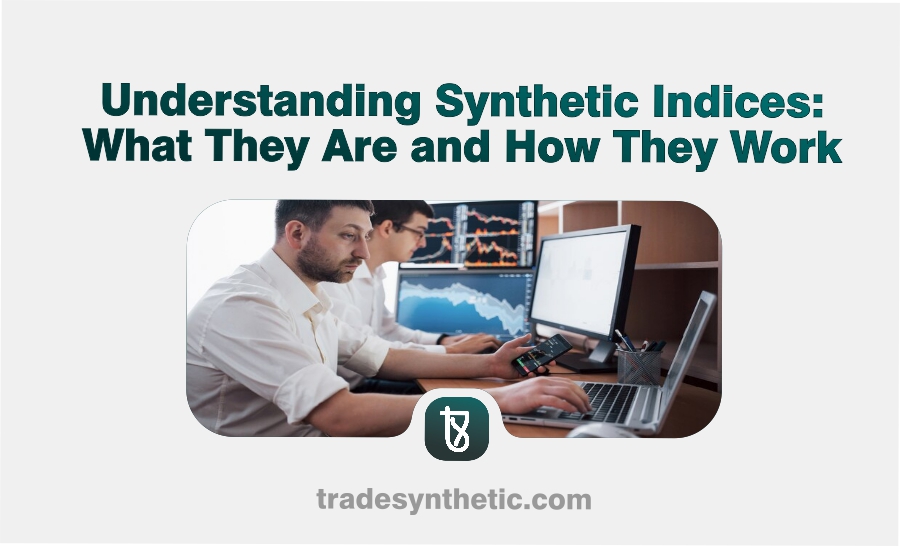If you are looking for an alternative to traditional financial markets, synthetic indices offer a unique trading opportunity. These indices are not tied to real-world assets like stocks or commodities but instead operate based on a complex algorithm designed to simulate real market conditions. Traders who engage with synthetic indices benefit from consistent volatility, transparent market behavior, and 24/7 availability.
In this guide, we will break down everything you need to know about synthetic indices, how they work, and how you can effectively trade them.
What Are Synthetic Indices?
Synthetic indices are simulated financial instruments that mimic real-market behaviors without being affected by external factors such as news, economic events, or market sentiment. Unlike forex, stocks, or commodities, these indices are generated using algorithms that ensure fairness and randomness.
Some popular types of synthetic indices include:
- Volatility Indices (VIX 10, VIX 25, VIX 50, VIX 75, and VIX 100)
- Crash and Boom Indices
- Step Indices
- Range Break Indices
Features of Synthetic Indices
Synthetic indices has some key features that is worthy of note.
Independence from Real-World Events
Unlike traditional financial markets, synthetic indices remain unaffected by geopolitical events, economic crises, or financial news. This unique characteristic ensures that traders do not have to worry about unexpected market disruptions caused by inflation reports, central bank decisions, or political instability. As a result, trading strategies can be more predictable and stable.
Constant Volatility
Different synthetic indices come with varying levels of volatility, allowing traders to select the ones that best suit their risk tolerance and trading strategy. High-volatility indices offer greater profit potential but come with increased risk, while lower-volatility indices provide a more stable trading environment. This flexibility enables traders to customize their approach based on market conditions and personal preferences.
Transparency and Fairness
The behavior of synthetic indices is algorithmically generated and verifiable, making them immune to price manipulation, insider trading, or external influence from large financial institutions. Every price movement is based on a provably fair algorithm, ensuring that all traders have equal access to opportunities without concerns over market manipulation.
Available 24/7
Unlike traditional stock or forex markets that operate within specific hours, synthetic indices are available for trading at any time of the day, including weekends and holidays. This round-the-clock accessibility allows traders to enter and exit positions based on their schedules without being restricted by market opening and closing times.
How Do Synthetic Indices Work?
Synthetic indices operate using a random number generator (RNG) that ensures their behavior is statistically sound and fair. This RNG is tested and certified by independent authorities to confirm its integrity.
How Prices Are Generated
Unlike real-world assets where prices fluctuate due to supply and demand, synthetic indices generate price movements based on predefined mathematical models. These models simulate real market conditions, creating trends, reversals, and breakout movements similar to traditional trading instruments.
Why Trade Synthetic Indices?
- No Market Manipulation – Prices are not affected by brokers or large institutions.
- High Volatility Opportunities – Traders can profit from high-frequency price movements.
- Round-the-Clock Trading – Unlike forex or stocks, synthetic indices do not close.
Best Strategies for Trading Synthetic Indices
To trade synthetic indices effectively, you need a well-structured strategy. Here are some of the best trading approaches:
1. Trend-Following Strategy
This involves identifying the prevailing trend and placing trades in the direction of that trend. You can use Moving Averages (e.g., 50 EMA and 200 EMA crossover) and Relative Strength Index (RSI) to confirm momentum
2. Breakout Strategy
This strategy focuses on trading when the price breaks out of a resistance or support level. It involves:
- Identifying consolidation phases
- Using Bollinger Bands to spot breakout points
3. Scalping Strategy
For traders who prefer short-term gains, scalping involves placing multiple trades within a short period to profit from small price movements.
4. Risk Management Strategy
Effective trading requires managing risk through Stop Loss and Take Profit Orders, Risk-to-Reward Ratio (1:2 or better) and Proper Leverage Usage.
How to Trade Synthetic Indices on Deriv
Deriv is one of the leading brokers offering synthetic indices trading. Follow these steps to start trading:
- Create a Deriv Account – Sign up on Deriv’s platform and complete account verification.
- Choose a Trading Platform – Deriv offers DTrader, Deriv MT5 (DMT5), and DBot for automated trading.
- Select a Synthetic Index – Pick from Volatility Indices, Crash and Boom, or Range Break Indices.
- Analyze the Market – Use technical indicators and trading strategies.
- Place a Trade – Define your trade size, set stop-loss, and take-profit levels.
- Monitor and Adjust – Keep an eye on market movements and adjust strategies accordingly.
Conclusion
In conclusion, Synthetic indices provide a unique and exciting alternative to traditional financial markets. With predictable market behavior, transparency, and 24/7 availability, they are an excellent option for traders seeking consistency. However, like any financial instrument, proper risk management and strategy implementation are crucial for success.
By understanding how synthetic indices work and using effective trading strategies, you can maximize your profitability while minimizing risks. Whether you’re a beginner or an experienced trader, synthetic indices offer opportunities for steady and reliable market engagement.
Frequently Asked Questions (FAQs)
Are synthetic indices real?
- No, synthetic indices are simulated markets created using a random number generator, ensuring fairness and transparency.
Can I make money trading synthetic indices?
- Yes, but success depends on your trading strategy, risk management, and market knowledge.
Are synthetic indices available on all brokers?
- No, they are primarily offered by brokers like Deriv.
Do synthetic indices have market opening hours?
- No, they are available 24/7, unlike forex and stock markets.
What is the best strategy for trading synthetic indices?
- It depends on your trading style. Trend-following, breakout, and scalping strategies are common approaches.










